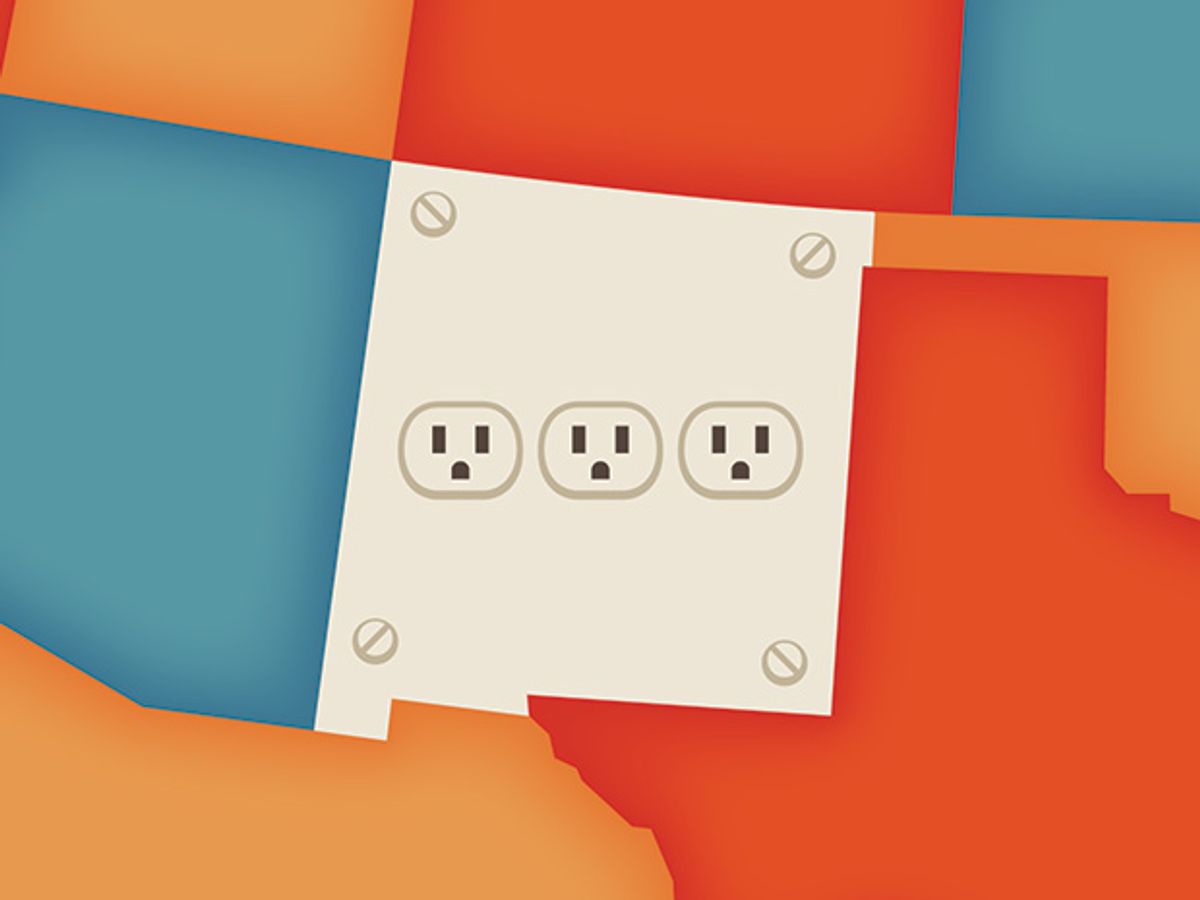Will the U.S. Finally Get a Unified Power Grid?
The long-delayed Tres Amigas superstation would help move up to 20 gigawatts of electricity around the continent

It is a decades-old dream: a single, vast North American electric grid, from the Atlantic to the Pacific, from Mexico to the Arctic Circle. Such a continent-wide supergrid would let officials transmit the tens of gigawatts of wind-generated power from the Great Plains to cities on both coasts. It would let Pacific Northwest hydropower flow to Chicago and let Texas wind power find its way to Massachusetts, Mississippi, and Montana. The benefits, measured in financial and reliability terms, would be fantastic. And yet despite many studies and even several attempts to create such a grid, it has never been achieved. The technology and the political will have been lacking.
In 2016, though, engineers will make a major stride in the former. An ambitious project known as Tres Amigas, eight years in the making, is finally getting under way. Eventually it will link the three largest North American grids: the Eastern Interconnection, the Western Interconnection, and the Texas Interconnection, which together cover the lower 48 states plus 8 Canadian provinces. Tres Amigas, located in eastern New Mexico, where the three grids converge, will be a transmission “superstation,” able to transfer up to 20 gigawatts of electricity in almost any direction.
Last November, construction workers began building the first piece of the first phase of the project: a 56-kilometer transmission line to connect three new wind farms to the superstation site and then to the Blackwater substation, which connects to the Western grid. The 345-kilovolt line is scheduled to be electrified by the end of 2016; Blackwater will also be upgraded to handle the added capacity of up to 500 megawatts of wind power.
The ultimate plan, with an estimated price tag of US $1.6 billion, is to construct three more lines to substations in Texas, one of which connects to the Texas grid (usually referred to as ERCOT, the acronym for the entity that runs it, the Electric Reliability Council of Texas), and the other two connecting to the Eastern grid.

The four sets of transmission lines would converge at Tres Amigas, a 58-square-kilometer site where the company will install high-voltage DC converters for converting AC to DC and back again, plus a modest 5 MW of storage for regulating voltage and frequency. As more partners sign on, additional converters and storage can be added. Other plans call for an electricity-market hub to let traders take advantage of the differences in electricity prices between regions. On 10 August 2015, for instance, the price difference between ERCOT and the Western grid hit $2,331.54 per megawatt-hour. Capitalizing on such disparities should generally lower rates for customers and stimulate more investment.
Having a high-voltage DC node that connects existing AC networks—a configuration called an HVDC overlay—will make the entire grid more stable and responsive to outages and faults, says Tres Amigas CEO Philip G. Harris. “Very large integrated AC systems tend to get wobbly,” he says. “An HVDC overlay, with its ability to move a lot of power quickly, will provide a huge reliability enhancement as the electricity grid grows.” Grid operators in Western Europe are already installing or planning a number of these HVDC overlays, he adds. China and India are going even further, installing transmission grids based entirely on HVDC.
Matter of Fact
A Proto-Supergrid: In 1918, engineer William Spencer Murray proposed a “Superpower Zone” [pdf] of transmission lines and power plants from Washington, D.C., to Boston.
A few links already exist between the main U.S. grids, such as the 200-MW HVDC converter station near Sidney, Neb., which connects the Eastern and Western grids, and the 220-MW HVDC station outside Oklaunion, Texas, which connects the Texas and Eastern grids. But Tres Amigas would bring together all three grids in one place and at much higher power levels.
Harris came up with the idea for Tres Amigas shortly after he retired as CEO of PJM, a regional grid and wholesale electricity market spanning the Middle Atlantic United States. In 2008, he says, “we drew up our plan, and within a few months we had several million dollars lined up.” Funding dried up with the global financial crisis. “The utilities told us they wanted Tres Amigas,” Harris says, but investors accustomed to funding electricity generation or transmission projects “had trouble trying to fit it in a ‘generation or transmission’ box.”
So Harris and his partners did everything except build the superstation: They completed the system assessments, lined up suppliers, leased land for the superstation, secured the rights of way, won regulatory approvals. The original timeline called for completion by 2013 but has been revised repeatedly. Last July, in fact, Excel Energy terminated an agreement with Tres Amigas that would have allowed the superstation to connect to the Eastern grid, citing missed deadlines going back several years. Harris is confident that the agreement will be revived once his group updates the interconnection studies to Tres Amigas.
The superstation’s design has also been revised. Current plans call for a more or less traditional power transmission node. But early schematics depicted a much more advanced concept: a superstation laid out in a triangular hub, with an HVDC converter station at each point and underground superconducting DC cables connecting those points.
“We called it the flux capacitor,” Andre Canelhas, a London-based HVDC expert who helped design Tres Amigas, says with a laugh, referring to the three-legged time-travel device from the sci-fi movie Back to the Future. “But in a sense, we are bringing the future to the present, where life is going to get a lot more interesting as renewables replace fossil-fuel plants, and we’ll need to move large blocks of power to where generation is suddenly insufficient. A project like Tres Amigas will make us evolve the way we need to evolve.”
This article originally appeared in print as “The U.S. May Finally Get a Unified Power Grid.”


